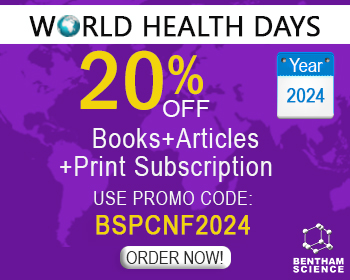Abstract
Neglected Tropical Diseases (NTDs) form a group of diseases that are strongly associated with poverty, flourish in impoverished environments, and thrive best in tropical areas, where they tend to present overlap. They comprise several diseases, and the symptoms vary dramatically from disease to disease, often causing from extreme pain, and untold misery that anchors populations to poverty, permanent disability, and death. They affect more than 1 billion people worldwide; mostly in poor populations living in tropical and subtropical climates. In this review, several complementary in silico approaches are presented; including identification of new therapeutic targets, novel mechanisms of activity, high-throughput screening of small-molecule libraries, as well as in silico quantitative structure-activity relationship and recent molecular docking studies. Current and active research against Sleeping Sickness, American trypanosomiasis, Leishmaniasis and Schistosomiasis infections will hopefully lead to safer, more effective, less costly and more widely available treatments against these parasitic forms of Neglected Tropical Diseases (NTDs) in the near future.
Keywords: Neglected tropical diseases, leishmaniasis, Trypanosoma cruzi, Trypanosoma brucei, Chagas disease, in silico.
[http://dx.doi.org/10.1073/pnas.1717806115] [PMID: 29284754]
[http://dx.doi.org/10.1016/j.exppara.2013.11.003] [PMID: 24269198]
[http://dx.doi.org/10.1590/s1678-9946201759091] [PMID: 29267599]
[http://dx.doi.org/10.1016/j.foodchem.2013.05.025] [PMID: 23870955]
[http://dx.doi.org/10.1002/jcb.24654] [PMID: 24038170]
[http://dx.doi.org/10.1155/2013/673058] [PMID: 23762152]
[http://dx.doi.org/10.1017/S0031182009991405] [PMID: 19961648]
[http://dx.doi.org/10.1007/s00044-011-9647-8]
[http://dx.doi.org/10.3390/molecules15107363] [PMID: 20966878]
[http://dx.doi.org/10.1128/MMBR.44.1.140-173.1980] [PMID: 6997722]
[http://dx.doi.org/10.3390/molecules18077761] [PMID: 23823876]
[http://dx.doi.org/10.1016/j.ijpddr.2013.10.001] [PMID: 24596663]
[http://dx.doi.org/10.2174/138161207780162809] [PMID: 17346174]
[http://dx.doi.org/10.1111/tmi.12483] [PMID: 25694261]
[http://dx.doi.org/10.1586/erm.12.72] [PMID: 23153239]
[http://dx.doi.org/10.1371/journal.pntd.0000720] [PMID: 20520803]
[http://dx.doi.org/10.1007/978-94-007-7305-9_2] [PMID: 24264240]
[http://dx.doi.org/10.3390/molecules19055550] [PMID: 24786692]
[http://dx.doi.org/10.1590/S0100-40422000000200007]
[http://dx.doi.org/10.2174/0929867003375317] [PMID: 10637360]
[http://dx.doi.org/10.1016/j.bmc.2012.04.062] [PMID: 22938785]
[http://dx.doi.org/10.1016/j.ejmech.2017.10.005] [PMID: 29031061]
[http://dx.doi.org/10.1371/journal.pntd.0001727] [PMID: 22848767]
[http://dx.doi.org/10.1016/j.bbagen.2015.10.015] [PMID: 26493722]
[http://dx.doi.org/10.1021/ci060046x] [PMID: 17238243 ]
[http://dx.doi.org/10.1016/j.phytochem.2004.12.006] [PMID: 15680991]
[http://dx.doi.org/10.1016/j.bmc.2007.02.005] [PMID: 17336532]
[http://dx.doi.org/10.1016/S0968-0896(01)00131-6] [PMID: 11504656]
[http://dx.doi.org/10.1055/s-2006-959526] [PMID: 7997472]
[http://dx.doi.org/10.3390/molecules17044684] [PMID: 22522398]
[http://dx.doi.org/10.1371/journal.pcbi.1000648] [PMID: 20098496]
[http://dx.doi.org/10.1080/1062936X.2017.1292407] [PMID: 28235390]
[http://dx.doi.org/10.3390/molecules200916154] [PMID: 26404225]
[http://dx.doi.org/10.1093/nar/gkx1198] [PMID: 29186511]
[http://dx.doi.org/10.1128/AAC.01263-13] [PMID: 24165182]
[http://dx.doi.org/10.1126/science.aal1807] [PMID: 28360328]
[http://dx.doi.org/10.1371/journal.pntd.0000803] [PMID: 20808768]
[http://dx.doi.org/10.3390/molecules200916154] [PMID: 26404225]
[http://dx.doi.org/10.3390/pathogens6030032] [PMID: 28726736]
[http://dx.doi.org/10.1371/journal.pntd.0003253] [PMID: 25340575]
[http://dx.doi.org/10.1371/journal.pone.0188219] [PMID: 29244877]
[http://dx.doi.org/10.1371/journal.pntd.0005886] [PMID: 28873407]
[http://dx.doi.org/10.1016/j.ejmech.2011.12.028] [PMID: 22217867]
[http://dx.doi.org/10.1016/S0306-3623(97)00268-1] [PMID: 9580315]
[http://dx.doi.org/10.1016/j.jep.2008.08.007] [PMID: 18775772]
[http://dx.doi.org/10.1016/j.bmc.2013.11.048] [PMID: 24355247]
[http://dx.doi.org/10.1155/2012/626838] [PMID: 23118748]
[http://dx.doi.org/10.1128/CMR.19.1.111-126.2006] [PMID: 16418526]
[http://dx.doi.org/10.1371/journal.pone.0035671] [PMID: 22693548]
[http://dx.doi.org/10.1371/journal.pntd.0002213] [PMID: 23675545]
[http://dx.doi.org/10.1111/j.1469-0691.2011.03630.x] [PMID: 21933306]
[http://dx.doi.org/10.1016/j.vaccine.2012.03.068] [PMID: 22475861]
[http://dx.doi.org/10.1016/j.ijpharm.2011.01.044] [PMID: 21277963]
[http://dx.doi.org/10.1016/j.jaad.2009.06.088] [PMID: 20303613]
[http://dx.doi.org/10.1016/S0035-9203(01)90223-8] [PMID: 11490989]
[http://dx.doi.org/10.1016/j.eimc.2009.06.010] [PMID: 19766360]
[PMID: 18472998]
[http://dx.doi.org/10.1186/1472-6882-13-48] [PMID: 23445637]
[http://dx.doi.org/10.1016/j.abb.2015.05.011] [PMID: 26045247]
[http://dx.doi.org/10.1016/j.ejmech.2016.03.022] [PMID: 27017551]
[http://dx.doi.org/10.1021/acs.jcim.6b00642] [PMID: 28322559]
[http://dx.doi.org/10.1371/journal.pcbi.1002499] [PMID: 22693435]
[http://dx.doi.org/10.2174/157340911795677602] [PMID: 21534921]
[http://dx.doi.org/10.2174/1386207319666160907100134] [PMID: 27604958]
[http://dx.doi.org/10.1038/sj.bjp.0707305] [PMID: 17549047]
[http://dx.doi.org/10.2174/1568026023392841] [PMID: 12470281]
[http://dx.doi.org/10.1016/S0167-6296(02)00126-1] [PMID: 12606142]
[http://dx.doi.org/10.1136/amiajnl-2013-001700] [PMID: 23757409]
[http://dx.doi.org/10.1021/ci500585w] [PMID: 25514239]
[http://dx.doi.org/10.5936/csbj.201302011] [PMID: 24688704]
[PMID: 1906917]
[http://dx.doi.org/10.1016/j.bmc.2012.06.051] [PMID: 22841617]
[http://dx.doi.org/10.1021/jm0493717] [PMID: 15588096]
[http://dx.doi.org/10.5897/AJMR-11-738]
[http://dx.doi.org/10.1111/j.1747-0285.2011.01262.x] [PMID: 22014034]
[http://dx.doi.org/10.1016/j.cbi.2016.12.004] [PMID: 27939867]
[http://dx.doi.org/10.1016/S0166-6851(01)00213-4] [PMID: 11295174]
[http://dx.doi.org/10.1073/pnas.91.24.11442] [PMID: 7972081]
[http://dx.doi.org/10.1016/j.jmgm.2017.07.013] [PMID: 28763686]
[http://dx.doi.org/10.1126/science.1112181] [PMID: 16020724]
[http://dx.doi.org/10.1371/journal.pone.0056788] [PMID: 23451087]
[http://dx.doi.org/10.1016/0166-6851(91)90126-Q] [PMID: 1775157]
[http://dx.doi.org/10.1128/AAC.40.4.947] [PMID: 8849257]
[http://dx.doi.org/10.1016/S0166-6851(98)00146-7] [PMID: 10029309]
[http://dx.doi.org/10.1080/14756360310001624966] [PMID: 15202494]
[http://dx.doi.org/10.1128/AAC.40.3.706] [PMID: 8851597]
[http://dx.doi.org/10.1007/978-1-4419-8414-2_6] [PMID: 21660660]
[http://dx.doi.org/10.1002/cmdc.201000420] [PMID: 21275053]
[http://dx.doi.org/10.1186/1471-2164-12-614] [PMID: 22182631]
[http://dx.doi.org/10.3390/molecules21050589] [PMID: 27164067]
[http://dx.doi.org/10.1590/s2175-97902017000116067]
[http://dx.doi.org/10.1002/cem.2789]
[http://dx.doi.org/10.1007/978-1-4020-6051-9_11] [PMID: 18084897]
[http://dx.doi.org/10.1016/j.molbiopara.2015.11.003] [PMID: 26592324]
[http://dx.doi.org/10.4155/fmc.13.146] [PMID: 24144416]
[http://dx.doi.org/10.1016/0022-2836(92)90701-K] [PMID: 1522596]
[http://dx.doi.org/10.1016/j.bmcl.2017.03.049] [PMID: 28359789]
[http://dx.doi.org/10.1016/j.bcp.2016.12.012] [PMID: 28017772]
[http://dx.doi.org/10.1016/j.ejmech.2015.10.011] [PMID: 26513640]
[http://dx.doi.org/10.1177/1934578X1501000630] [PMID: 26197515]
[http://dx.doi.org/10.1016/j.biopha.2016.06.010] [PMID: 27470561]
[http://dx.doi.org/10.1016/j.jmgm.2013.12.010] [PMID: 24463105]
[http://dx.doi.org/10.1007/s00436-014-3850-8] [PMID: 24691716]
[http://dx.doi.org/10.6026/97320630010353] [PMID: 25097378]
[http://dx.doi.org/10.1021/acs.joc.6b00113] [PMID: 26999637]
[http://dx.doi.org/10.4155/fmc-2018-0512] [PMID: 31370699]
[http://dx.doi.org/10.1080/07391102.2015.1085904] [PMID: 26305585]
[http://dx.doi.org/10.1080/07391102.2015.1135298] [PMID: 27043972]
[http://dx.doi.org/10.3109/10799893.2016.1171344] [PMID: 27147242]
[http://dx.doi.org/10.1002/ardp.201500312] [PMID: 26627058]
[http://dx.doi.org/10.2174/1386207319666160907102235] [PMID: 27604957]
[http://dx.doi.org/10.1007/s00018-017-2653-3] [PMID: 28900667]
[http://dx.doi.org/10.1016/j.bmcl.2015.12.085] [PMID: 26778149]
[http://dx.doi.org/10.3390/ijms17071141] [PMID: 27428963]
[http://dx.doi.org/10.1016/j.bioorg.2017.02.005] [PMID: 28228228]
[http://dx.doi.org/10.1074/jbc.M110.209593] [PMID: 21239486]
[http://dx.doi.org/10.1111/j.1365-2958.2010.07236.x] [PMID: 20545846]
[http://dx.doi.org/10.1017/S0031182097001133] [PMID: 9309772]
[http://dx.doi.org/10.1016/j.bmcl.2017.06.053] [PMID: 28693910]
[http://dx.doi.org/10.1016/j.bmcl.2014.01.035] [PMID: 24513045]
[http://dx.doi.org/10.1016/j.exppara.2013.07.004] [PMID: 23872452]
[http://dx.doi.org/10.1016/j.ejmech.2014.12.051] [PMID: 25576738]
[http://dx.doi.org/10.1016/j.ejmech.2016.12.019] [PMID: 28012342]
[http://dx.doi.org/10.1016/j.ejmech.2015.02.038] [PMID: 25768697]
[http://dx.doi.org/10.1016/j.ejmech.2017.03.043] [PMID: 28407565]
[http://dx.doi.org/10.1080/14786419.2015.1126260] [PMID: 26755152]
[http://dx.doi.org/10.3390/molecules22030426] [PMID: 28282886]
[http://dx.doi.org/10.3390/molecules22122166] [PMID: 29211037]
[http://dx.doi.org/10.1007/s12639-010-0006-3] [PMID: 21526026]
[http://dx.doi.org/10.1021/jm300563f] [PMID: 22946585]
[http://dx.doi.org/10.1074/jbc.272.21.13883] [PMID: 9153248]
[http://dx.doi.org/10.1146/annurev.pathol.1.110304.100151] [PMID: 18039124]
[http://dx.doi.org/10.1016/S0166-6851(01)00438-8] [PMID: 11849701]
[http://dx.doi.org/10.1515/znc-2007-5-610] [PMID: 17708443]
[http://dx.doi.org/10.1007/s00436-007-0706-5] [PMID: 17726617]
[http://dx.doi.org/10.1016/j.molbiopara.2010.09.003] [PMID: 20883728]
[http://dx.doi.org/10.1007/s00894-014-2099-6] [PMID: 24567150]
[http://dx.doi.org/10.1017/S0031182016002237] [PMID: 28031079]
[http://dx.doi.org/10.1016/j.bmcl.2015.06.085] [PMID: 26169126]
[http://dx.doi.org/10.1186/1472-6807-9-9] [PMID: 19243605]
[http://dx.doi.org/10.3390/molecules18055032] [PMID: 23629757]
[http://dx.doi.org/10.1021/bi00046a004] [PMID: 7578111]
[http://dx.doi.org/10.1016/j.ejmech.2015.06.014] [PMID: 26107111]
[http://dx.doi.org/10.1054/drup.2000.0177] [PMID: 11512153]
[http://dx.doi.org/10.1155/2015/965725] [PMID: 25918726]
[http://dx.doi.org/10.1021/jm000472o] [PMID: 11405646]
[http://dx.doi.org/10.1016/j.bbabio.2012.09.008] [PMID: 22995215]
[http://dx.doi.org/10.1016/j.jmgm.2013.12.001] [PMID: 24370672]
[http://dx.doi.org/10.1016/0304-4165(78)90104-6] [PMID: 719006]
[http://dx.doi.org/10.1016/j.ijbiomac.2015.11.051] [PMID: 26616453]
[http://dx.doi.org/10.1074/jbc.273.3.1534] [PMID: 9430693]
[http://dx.doi.org/10.1007/s00018-008-8123-1] [PMID: 18560757]
[http://dx.doi.org/10.1007/978-0-387-77570-8_10] [PMID: 18365663]
[http://dx.doi.org/10.1155/2013/609289] [PMID: 23984386]
[http://dx.doi.org/10.1039/c0mb00307g] [PMID: 21528129]
[http://dx.doi.org/10.1016/0305-0491(73)90070-9] [PMID: 4351428]
[http://dx.doi.org/10.1002/(SICI)1097-4652(200002)182:2<144:AID-JCP2>3.0.CO;2-6] [PMID: 10623877]
[http://dx.doi.org/10.1023/A:1005584929050] [PMID: 11768308]
[http://dx.doi.org/10.1111/j.1365-2958.1996.tb02538.x] [PMID: 8809750]
[http://dx.doi.org/10.1007/s10822-017-0022-9] [PMID: 28551817]
[http://dx.doi.org/10.1371/journal.pntd.0003588] [PMID: 25768284]
[http://dx.doi.org/10.1186/2193-1801-3-679] [PMID: 25932361]
[http://dx.doi.org/10.1194/jlr.M021865] [PMID: 22135275]
[http://dx.doi.org/10.1016/j.parint.2016.01.001] [PMID: 26772973]
[http://dx.doi.org/10.4155/fmc.13.114] [PMID: 24144413]
[http://dx.doi.org/10.1107/S1744309112019124] [PMID: 22750854]
[http://dx.doi.org/10.1016/j.molbiopara.2009.04.009] [PMID: 19409421]
[http://dx.doi.org/10.1016/j.bmcl.2017.04.010] [PMID: 28434763]
[http://dx.doi.org/10.1016/S0169-409X(00)00129-0] [PMID: 11259830]
[http://dx.doi.org/10.1016/j.ijpara.2007.03.008] [PMID: 17493624]
[http://dx.doi.org/10.1371/journal.pone.0077460] [PMID: 24146999]
[http://dx.doi.org/10.1371/journal.ppat.1000555] [PMID: 19696894]
[http://dx.doi.org/10.1007/978-94-007-7305-9_4] [PMID: 24264242]
[http://dx.doi.org/10.1371/journal.pone.0078387] [PMID: 24260115]
[http://dx.doi.org/10.1016/j.molbiopara.2009.01.001] [PMID: 19393161]
[http://dx.doi.org/10.1016/S0020-7519(02)00002-4] [PMID: 12062491]
[http://dx.doi.org/10.1080/20477724.2017.1312777] [PMID: 28385129]
[http://dx.doi.org/10.1371/journal.pntd.0000675] [PMID: 20454559]
[http://dx.doi.org/10.1016/j.abb.2008.11.003] [PMID: 19014901]
[http://dx.doi.org/10.1128/AAC.48.8.2937-2950.2004] [PMID: 15273104]
[http://dx.doi.org/10.1007/s11033-014-3299-y] [PMID: 24574002]
[http://dx.doi.org/10.1080/07391102.2014.1002423] [PMID: 25669324]
[http://dx.doi.org/10.1016/S0166-6851(01)00220-1] [PMID: 11295173]
[http://dx.doi.org/10.1006/expr.1996.0012] [PMID: 8617352]
[http://dx.doi.org/10.1186/1475-9292-4-6] [PMID: 16384531]
[http://dx.doi.org/10.1016/j.ijpara.2007.04.008] [PMID: 17548090]
[http://dx.doi.org/10.1007/s12539-013-0164-y] [PMID: 23740395]
[http://dx.doi.org/10.1007/s12539-015-0269-6] [PMID: 26264054]
[http://dx.doi.org/10.1146/annurev.bi.65.070196.003223] [PMID: 8811192]
[http://dx.doi.org/10.1016/j.pt.2004.06.005] [PMID: 15246322]
[http://dx.doi.org/10.1128/AAC.00352-16] [PMID: 27503653]
[http://dx.doi.org/10.3390/molecules200713384] [PMID: 26205061]
[http://dx.doi.org/10.1016/B978-0-12-802508-6.00027-2]
[http://dx.doi.org/10.1002/jmr.2471] [PMID: 25808539]
[http://dx.doi.org/10.2147/AABC.S105289] [PMID: 27390530]
[http://dx.doi.org/10.1002/cmdc.201500385] [PMID: 26492824]
[http://dx.doi.org/10.1016/j.drudis.2015.02.004] [PMID: 25697479 ]
[http://dx.doi.org/10.1080/07391102.2016.1176603] [PMID: 27064715]
[http://dx.doi.org/10.4155/fmc-2016-0236] [PMID: 28509592]
[http://dx.doi.org/10.1007/s10822-017-0039-0] [PMID: 28795372]
[http://dx.doi.org/10.2174/1573406412666160701022230] [PMID: 27396731]
[http://dx.doi.org/10.1371/journal.pntd.0003773] [PMID: 26042772]
[http://dx.doi.org/10.1016/j.compbiolchem.2016.10.002] [PMID: 27744094]
[http://dx.doi.org/10.1007/s00894-016-3115-9] [PMID: 27665464]
[http://dx.doi.org/10.1016/j.ejmech.2016.10.055] [PMID: 27810595]
[http://dx.doi.org/10.1016/j.jmgm.2015.02.002] [PMID: 25829097]
[http://dx.doi.org/10.3390/molecules21030368] [PMID: 26999093]
[http://dx.doi.org/10.1016/j.jmgm.2017.08.007] [PMID: 28865321]
[http://dx.doi.org/10.1080/07391102.2015.1038584] [PMID: 26046477]
[http://dx.doi.org/10.1007/s10822-016-9985-1] [PMID: 27770305]
[http://dx.doi.org/10.1371/journal.pone.0158434] [PMID: 27367145]
[http://dx.doi.org/10.1038/s41598-017-06411-9] [PMID: 28751689]
[http://dx.doi.org/10.3390/molecules21101389] [PMID: 27775577]
[http://dx.doi.org/10.1007/s12539-011-0101-x] [PMID: 21956744]
[http://dx.doi.org/10.1055/s-0033-1351916]
[http://dx.doi.org/10.3390/molecules23010103] [PMID: 29301376]
[http://dx.doi.org/10.1039/c0np00069h] [PMID: 21290079]
[http://dx.doi.org/10.2174/157488470903140806114147] [PMID: 23173969]
[http://dx.doi.org/10.1177/1934578X1501000630] [PMID: 26197515]
[http://dx.doi.org/10.1177/1934578X1601100118] [PMID: 26996020]
[http://dx.doi.org/10.1007/s00044-014-1122-x]
[http://dx.doi.org/10.3390/molecules22010079] [PMID: 28054952]
[http://dx.doi.org/10.2174/13895575113139990066] [PMID: 23815577]
[http://dx.doi.org/10.1371/journal.pntd.0002689] [PMID: 24551254]
[http://dx.doi.org/10.1021/ci049714+] [PMID: 15667143]
[http://dx.doi.org/10.1016/j.jmgm.2014.11.002] [PMID: 25528729]
[http://dx.doi.org/10.1021/ci300400a] [PMID: 23030379]
[http://dx.doi.org/10.1021/jm901137j] [PMID: 20131845]
[http://dx.doi.org/10.4155/fmc.11.44] [PMID: 21644825]
[http://dx.doi.org/10.2147/DDDT.S120618] [PMID: 28435221]
[http://dx.doi.org/10.1017/S0031182011001429] [PMID: 21902869]
[http://dx.doi.org/10.1021/acs.jmedchem.5b00104] [PMID: 25860834]
[http://dx.doi.org/10.1128/AAC.02205-17] [PMID: 29203486]
[http://dx.doi.org/10.1021/ci400250c] [PMID: 23901898]
[http://dx.doi.org/10.1128/AAC.01936-17] [PMID: 29203485]
[http://dx.doi.org/10.1016/j.ejmech.2017.12.052] [PMID: 29289882]
[http://dx.doi.org/10.1021/ci300367a] [PMID: 23092397]
[http://dx.doi.org/10.1007/s10822-016-9903-6] [PMID: 26891837]
[http://dx.doi.org/10.1093/nar/gkq1126] [PMID: 21059682]
[http://dx.doi.org/10.1371/journal.pone.0079568] [PMID: 24223973]


























